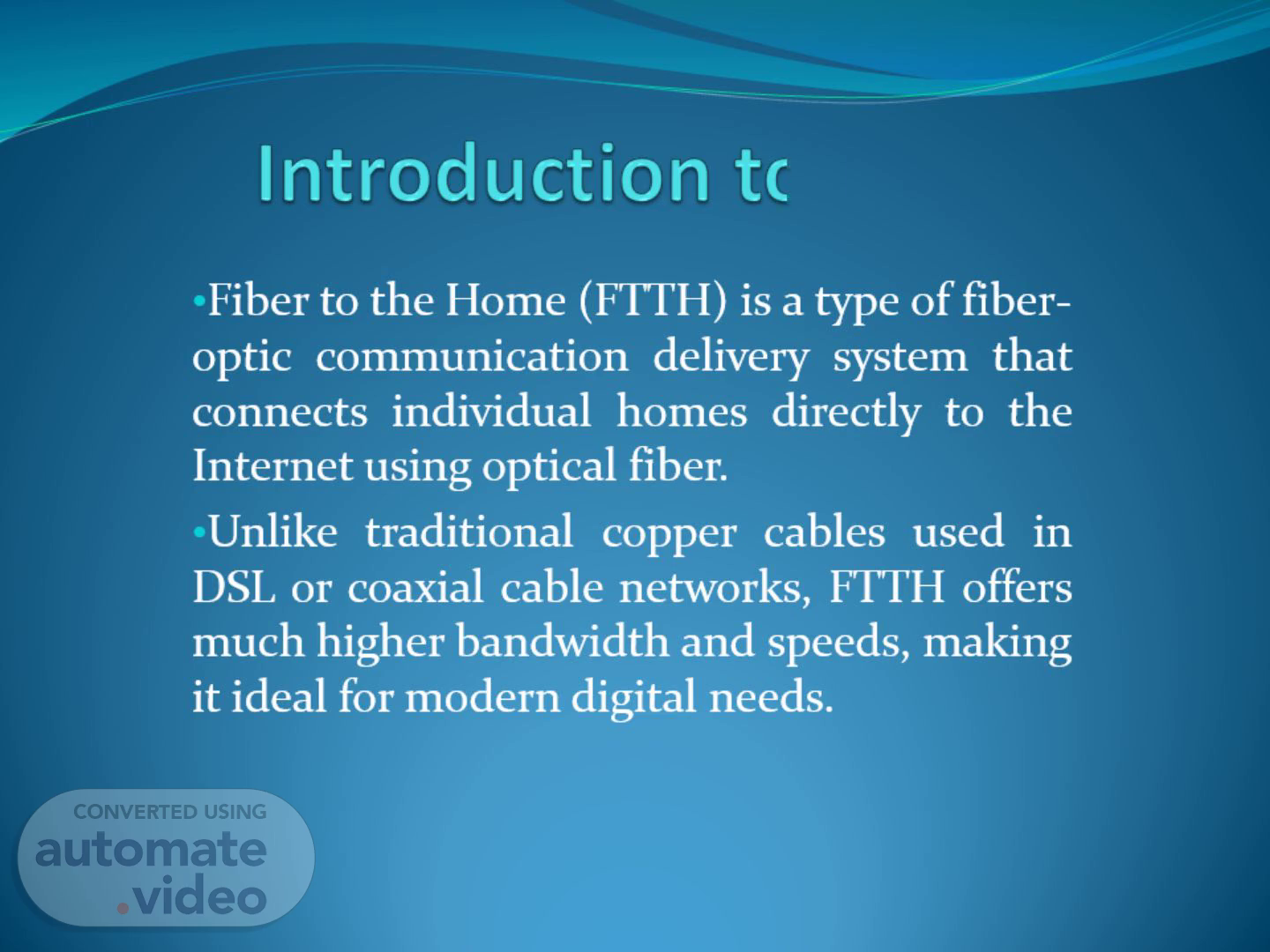Scene 1 (0s)
Introduction to FTTH. Fiber to the Home (FTTH) is a type of fiber-optic communication delivery system that connects individual homes directly to the Internet using optical fiber. Unlike traditional copper cables used in DSL or coaxial cable networks, FTTH offers much higher bandwidth and speeds, making it ideal for modern digital needs..
Scene 2 (16s)
Evolution of Broadband Technologies. Over the past decades, broadband technologies have evolved from dial-up to DSL, cable internet, and now fiber optics. Fiber-optic technology represents a significant leap in data transmission, utilizing light signals for high-speed communication. FTTH is the latest step in this evolution, offering end-to-end fiber connectivity..
Scene 3 (34s)
Technical Architecture of FTTH. Optical Line Terminal (OLT): Located at the provider's central office, it sends data to and receives data from homes. Optical Distribution Network (ODN): This includes fiber cables, splitters, and other passive components that distribute the optical signal. Optical Network Terminal (ONT): Installed at the user end, it converts optical signals into electrical signals for devices in the home..
Scene 4 (54s)
FTTH Architecture. FTTH PON Architecture Fiber Optic Cable Fiber Optic Cable OLT.
Scene 5 (1m 1s)
FTTH Power Budget. FTTH Power Budget refers to the calculation of optical power loss in a fiber optic link between the Optical Line Terminal (OLT) at the service provider's central office and the Optical Network Terminal (ONT) at the customer premises. It helps ensure the signal strength at the receiving end is within acceptable limits..
Scene 6 (1m 17s)
Key Components in FTTH Power Budget. Transmitter Power (TX): Output power from the OLT (typically in dBm). Receiver Sensitivity (RX): Minimum power required at the ONT to operate reliably (in dBm). Fiber Attenuation: Loss per km (usually ~0.35 dB/km for 1310 nm, ~0.25 dB/km for 1550 nm). Splice Losses: ~0.1 dB per fusion splice. Connector Losses: ~0.2 dB per connector. Splitter Losses: 1:2 → ~3.5 dB 1:4 → ~7.2 dB 1:8 → ~10.5 dB 1:16 → ~13.5 dB 1:32 → ~17 dB.
Scene 7 (1m 47s)
Link power budget Fiber segments with loss a Flylead Connector N splices Connector Flylead loss model for point to point link Figure 3.19.
Scene 8 (1m 56s)
Power Budget Formula: Power Budget=TX Power−RX Sensitivity Total Link Loss=Fiber Loss+Splice Losses+Connector Losses+Splitter To be valid: Power Budget≥Total Link.
Scene 9 (2m 3s)
Example Calculation: TX Power (OLT): +3 dBm RX Sensitivity (ONT): –27 dBm Distance: 10 km Fiber Loss: 0.35 dB/km × 10 = 3.5 dB 2 connectors: 0.2 × 2 = 0.4 dB 4 splices: 0.1 × 4 = 0.4 dB 1:16 splitter: ~13.5 dB Margin: 3 dB Total Loss=3.5+0.4+0.4+13.5+3=20.8 dB Power Budget=3−(−27)=30dB ✅ Conclusion: 30 dB > 20.8 dB → Link is valid.
Scene 10 (2m 26s)
Types of FTTH Deployment. Active Optical Network (AON): Uses electrically powered equipment to manage signal distribution. Passive Optical Network (PON): Relies on unpowered splitters to divide signals among users. Gigabit Passive Optical Network (GPON): A popular standard that supports high bandwidth for internet, video, and voice..
Scene 11 (2m 42s)
Benefits of FTTH. High-Speed Internet: Supports gigabit-speed downloads and uploads. Reliability: Resistant to electromagnetic interference and weather conditions. Scalability: Capable of supporting future technologies like 8K video and IoT. Low Latency: Ideal for online gaming and video conferencing..
Scene 12 (2m 57s)
FTTH vs. Other Technologies. Technology DSL Cable FTTH Max Speed Up to 100 Mbps Up to 1 Gbps Up to 10 Gbps Reliability Moderate Moderate High Scalability Moderate Very High FTTH clearly outperforms other broadband technologies in terms of speed, reliability, and future readiness..
Scene 13 (3m 9s)
Applications of FTTH. Home Entertainment: Streaming 4K/8K videos, online gaming. Remote Work: Stable video conferencing and cloud computing. E-learning: Seamless virtual classrooms and content delivery. Smart Homes: Supports IoT devices and automation systems. Telemedicine: Enables remote diagnostics and consultations..
Scene 14 (3m 25s)
Challenges in FTTH Implementation. High Initial Cost: Laying fiber cables is expensive. Geographical Barriers: Difficult to deploy in remote or rugged areas. Regulatory Hurdles: Requires permissions and coordination with local authorities. Maintenance: While durable, fiber lines can still be damaged by construction or accidents..
Scene 15 (3m 41s)
Conclusion and Future Outlook. FTTH is revolutionizing digital connectivity with unmatched speed and reliability. As digital demand grows, FTTH is becoming the foundation for smart cities, digital services, and next-gen technologies. Investing in FTTH now prepares societies for a connected, high-speed future..
